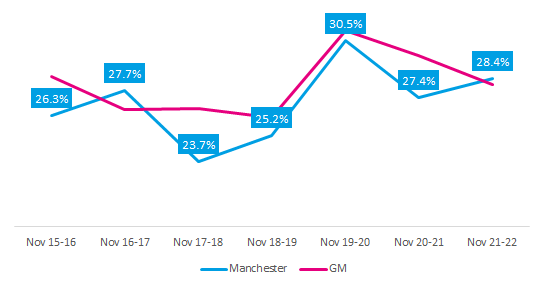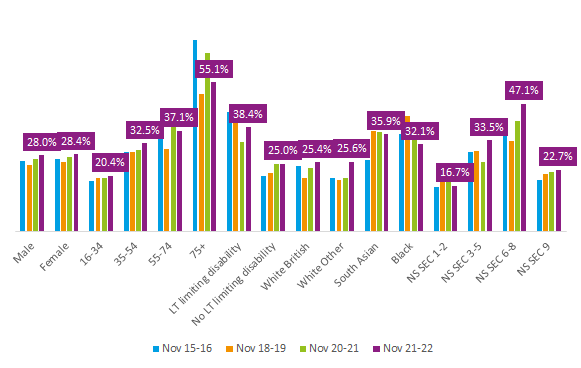Manchester Adult Activity Levels 2021-22
Manchester has recovered to baseline levels for active (61.0%) but not recovered to pre-pandemic levels for both active and inactive (28.4%).
Manchester Overview
Manchester has recovered to baseline levels for active (61.0%) but has seen an increase in the last 12 months for inactive (28.4%).
Only those aged 55-74 and 75+, from South Asian or Black ethnic groups have seen a decrease in inactivity in the last 12 months.
Those over 35 years have higher inactivity levels in Manchester than GM, as well as from NS SEC 3-5 and 6-8 groups especially.
Inactivity
The inactive population has seen an increase in the last 12 months (+1.1%), is still above baseline (+2.1%) and higher than pre-pandemic levels (+3.2 %).

Differences across demographics
Similar to GM, 16-34 years, South Asian and Black ethnic groups and NS SEC 9 groups were all higher than baseline before the pandemic. As well as those aged 35-54 years, those with no LTHC and NS SEC 1-2 and 3-5.
Only males, females, White British ethnic groups, 75+ years, NS SEC 6-8 groups and those with a LTHC were showing a gradual decrease.
Those aged 55-74 and 75+ years and from NS SEC 6-8 groups were most impacted by the pandemic.
Most demographics have not recovered to either baseline or pre-pandemic levels, apart from NS SEC 1-2 groups, those with a LTHC and from Black ethnic groups. Those aged 75+ have recovered to baseline, but not pre-pandemic, and from South Asian ethnic groups have recovered to pre-pandemic, but not baseline.
Those over 35 years have higher inactivity levels in Manchester than GM, as well as from NS SEC 3-5 and 6-8 groups especially.

If you have questions about this data please email: [email protected]
Published April 2023
